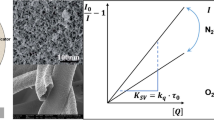Abstract
The dye Erythrosine B (which gives room-temperature phosphorescence, RTF) has been covalently bound to a silica-based amino-functionalized exchanger. The resulting material turned out to be extremely useful as a luminescent probe for oxygen. The photochemical properties and the analytical performance of the RTF probe have been studied by use of a gas flow-injection analysis system, which incorporates a convenient exponential dilution chamber for gas sample introduction. The possible origin of the non-linear Stern-Volmer quenching response observed is thoroughly discussed in terms of the quenching and lifetimes. The proposed sensing material is particularly suitable for measuring oxygen in gas mixtures at extremely low concentrations. The detection limit attained was 0.00006% (0.6 ppm) of oxygen in dry argon (making the system one of the more sensitive optosensors for oxygen published so far). A typical precision of ± 0.2%, at the 0.025% oxygen level, was achieved. Response times were less than 2 s for full signal change and no hysteresis effects were noticed. A possible mechanism for the observed oxygen RTF quenching in the new sensing material is proposed.
Similar content being viewed by others
References
O. S. Wolfbeis (ed.),Fiber Optic Chemical Sensors and Biosensors, Vols. 1 and 2, CRC, Boca Raton, Florida, 1991.
O. S. Wolfbeis, M. J. P. Leiner,SPIE Optical Fibers in Medicine III 1988,906, 42.
Y.-M. Liu, R. Pereiro-Garcia, M. J. Valencia González, M. E. Díaz-García, A. Sanz-Medel,Anal. Chem. 1994,66, 836.
W. Xu, R. C. McDonough III, B. Langsdorf, J. N. Demas, B. A. DeGraff,Anal. Chem. 1994,66, 4133.
H. Kautsky, A. Hirsch,Ber. Dtsch. Chem. Ges. 1931,64, 2677.
M. E. Díaz-García, R. Pereiro-García, N. Velasco-García,Analyst 1995,120, 457.
D. B. Papkovsky,Sens. Actuators B 1993,11, 293.
P. M. Gewehr, D. T. Delpy,Med. Biol. Eng. Comput. 1993,31, 11.
X.-M. Li, K.-Y. Wong,Anal. Chin. Acta 1992,262, 27.
O. S. Wolfbeis,J. Molec. Structure 1993,292, 133.
J. E. Lovelock,Anal. Chem. 1961,33, 162.
M. E. Díaz-García, A. Sanz-Medel,Anal. Chem. 1986,58, 1436.
R. J. Hurtubise,Phosphorimetry. Theory, Instrumentation and Applications, VCH, New York, 1990.
A. Chartier, J. Georges, J. M. Mermet,Spectrochim. Acta A 1990,46, 1737.
P. Y. F. Li, R. Narayanaswamy,Analyst 1989,114, 1191.
N. Velasco García, R. Pereiro-García, M. E. Díaz-García,Spectrochim. Acta A 1995,51, 895.
Author information
Authors and Affiliations
Rights and permissions
About this article
Cite this article
Badía, R., Díaz-García, M.E. & García-Fresnadillo, A. A sensitive probe for oxygen sensing in gas mixtures, based on room-temperature phosphorescence quenching. Mikrochim Acta 121, 51–61 (1995). https://doi.org/10.1007/BF01248240
Received:
Revised:
Issue Date:
DOI: https://doi.org/10.1007/BF01248240




